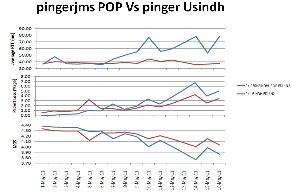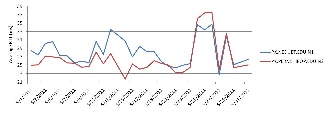In reference to the HEC meeting to be held in the last week of May 2011, we tried to analyse the network performance for PoP node (pingerjms.pern.edu.pk) and Non PoP node (pinger.usindh.edu.pk) both at University of Sindh Jamshoro.
Metric Measurements and Results
Looking at the pingtable.pl and getting data from Pakistan to pingerjms and Pakistan to usindh node, we see the following results that show the performance of both of the nodes in the first 15 days of May.
Find spreadsheet here.
The graphs clearly show that the PoP node performance is worse than the non-PoP node. In order to get a better insight into finding the reason of this degraded performance, we looked at the traceroutes for both of the nodes from pinger.pern.edu.pk (Islamabad Pern PoP). However, the traceroutes for both of the nodes are throwing error messages.
RTTs seen from PoP Islamabad (pinger.pern.edu.pk)
The next thing we want is to see the picture of network performance while accessing both of the nodes from one central node and not from whole of the Pakistan. For this, we chose PoP Islamabad as monitoring node and accessed Usindh (pinger.usindh.edu.pk) and Usindh PoP (pingerjms.pern.edu.pk)
Going to http://www-wanmon.slac.stanford.edu/cgi-wrap/connectivity.pl?format=csv&rawdata=pinger.usindh.edu.pk&days=6&monitor=pinger.pern.edu.pk and http://www-wanmon.slac.stanford.edu/cgi-wrap/connectivity.pl?format=csv&rawdata=pingerjms.pern.edu.pk&days=6&monitor=pinger.pern.edu.pk we collected the data for past 7 days and plotted it in excel to see the curves for Average RTT and Min RTT.
Min RTT from Pern Islamabad |
Average RTT from Pern Islamabad |
|---|---|
|
|
We see that the min of min RTT for PoP was 35.827ms , avg of min RTT was 36.02, max of min RTT was 36.203, IQR of min RTT was 0.294 (see table for pingerjms.pern.edu.pk column 1 and 2).
pingerjms.pern.edu.pk |
Min RTT (ms) |
Avg RTT (ms) |
Max RTT (ms) |
|---|---|---|---|
Min |
35.827 |
35.879 |
35.91 |
Avg |
36.02 |
36.07 |
36.16 |
Max |
36.203 |
36.293 |
36.711 |
Median |
36.131 |
36.174 |
36.224 |
IQR |
0.294 |
0.295 |
0.293 |
Similarly, we have the min, avg, max, median and IQR for Min RTT, Average RTT and Max RTT for the usindh node in the table shown below.
pinger.usindh.edu.pk |
Min RTT (ms) |
Avg RTT (ms) |
Max RTT (ms) |
|---|---|---|---|
Min |
36.388 |
36.973 |
37.057 |
Avg |
37.04 |
37.23 |
37.511 |
Max |
37.352 |
39.032 |
44.613 |
Median |
37.023 |
37.252 |
37.381 |
IQR |
0.271 |
0.27 |
0.332 |
These tables can also be viewed in the spreadsheet attached.
On average there is a difference of 1.02ms in Min RTT, 1.16ms in Average RTT and 1.35ms in Max RTT for the two nodes. Usindh PoP is performing better than Usindh non-PoP node.
Another interesting information is that for PoP node, difference in min of min RTT for 1000 bytes and 100 bytes of data is 0.287ms. This means that 900 bytes of data take a min RTT of 0.287ms to reach PoP usindh. This makes the bottleneck capacity to be 25.087Mbps. On the other hand for usindh non-PoP node, difference in min of min RTT for 1000 bytes and 100 bytes of data is 0.638ms. This means that 900 bytes of data take a min RTT of 0.638ms to reach PoP usindh. This makes the bottleneck capacity to be 11.285 Mbps.
Traceroute Results from pinger.pern.edu.pk
While trying to access pingerjms.pern.edu.pk (PoP Jamshoro) from pinger.pern.edu.pk (PoP Islamabad) following traceroute results were obtained
Executing exec(traceroute, -m 30 -q 3 -f 3, 121.52.154.2, 140) traceroute to 121.52.154.2 (121.52.154.2), 30 hops max, 140 byte packets 4 rwp44.pie.net.pk (221.120.251.58) 35.530 ms 35.491 ms 35.424 ms 5 khi77.pie.net.pk (221.120.205.70) 36.129 ms 36.417 ms 36.490 ms 6 pinger.hyd.usindh.edu.pk (121.52.154.2) 35.945 ms 35.931 ms 35.916 ms
However, while accessing usindh (non PoP Jamshoro) we found
Executing exec(traceroute, -m 30 -q 3 -f 3, 121.52.155.62, 140) traceroute to 121.52.155.62 (121.52.155.62), 30 hops max, 140 byte packets 4 rwp44.pie.net.pk (221.120.251.58) 35.473 ms 35.442 ms 35.451 ms 5 khi77.pie.net.pk (221.120.205.70) 36.107 ms 36.347 ms 36.388 ms 6 172.31.253.66 (172.31.253.66) 36.077 ms 36.201 ms 36.248 ms 7 usindh.edu.pk (121.52.156.130) 36.550 ms 36.583 ms 36.623 ms 8 (121.52.155.62) 36.917 ms !X 36.899 ms !X 36.885 ms !X
Extra hops can be seen in Usindh traceroute (hop 6 and 7). For both of the nodes, it takes 36.105 ~ 36.4 ms to reach the hop khi77.pie.net.pk, however, as the hops are increased for accessing usindh , an increased RTT of 0.9 ms is observed. This is a small difference in RTT for the two nodes which is added due to two extra hops and it supports the results shown above in graphs.
It is observed that a bimodal pattern is seen in min RTT, that is for Pern POP min RTT was 35.87 ms till 6th of june and then it increased to 36.16 ms. Similar is the case for non PoP usindh node. However when we compared the traceroutes on 5th June and 8th June, it was found that there weren't any additional hops. The increase in min RTT was due to the hops of rwp44.pie.net.pk and khi77.pie.net.pk showing increased RTT. See below the traceroute results for 5th June from Pern PoP Islamabad to Pern PoP Jamshoro
Executing exec(traceroute, -m 30 -q 3 -f 3, 121.52.155.62, 140) traceroute to 121.52.155.62 (121.52.155.62), 30 hops max, 140 byte packets 4 rwp44.pie.net.pk (221.120.251.58) 35.475 ms 35.443 ms 35.426 ms 5 khi77.pie.net.pk (221.120.205.70) 36.104 ms 36.332 ms 36.394 ms 6 172.31.253.66 (172.31.253.66) 36.084 ms 36.184 ms 36.238 ms 7 usindh.edu.pk (121.52.156.130) 36.701 ms 36.821 ms 36.757 ms 8 (121.52.155.62) 37.273 ms !X 37.258 ms !X 37.244 ms !X
And the traceroute results on 8th June were as below:
Executing exec(traceroute, -m 30 -q 3 -f 3, 121.52.155.62, 140) traceroute to 121.52.155.62 (121.52.155.62), 30 hops max, 140 byte packets 4 rwp44.pie.net.pk (221.120.251.58) 35.770 ms 35.710 ms 35.721 ms 5 khi77.pie.net.pk (221.120.205.70) 41.929 ms 41.979 ms 42.033 ms 6 172.31.253.66 (172.31.253.66) 36.404 ms 36.572 ms 36.593 ms 7 usindh.edu.pk (121.52.156.130) 36.901 ms 37.043 ms 36.959 ms 8 (121.52.155.62) 37.442 ms !X 37.427 ms !X 37.411 ms !X
A slight increase in RTT is seen for the two above mentioned hops. So far we are unable to find out the reason for this increase in RTT for these two hops. A similar increase in RTT is seen for the same two hops for the non PoP node (pinger.usindh.edu.pk) as well.
Comparison of Khi-PoP and NEDUET
As the results of jamshoro and university of sindh do not go with the theoretical analysis, we tried to find out the performance of other PoPs as compared to one other pern node in the same city.
First we chose Karachi POP and NEDUET. For the time being we only compared the average RTT.
Karachi PoP is performing better than neduet.
Now we want to confirm it by checking some other POP and non POP pair.
Comparison of Islamabad-PoP and NCP
We now tried to compare the average RTT from Pakistan to PERN POP Islamabad and to NCP (National College of Physics, Islamabad).
Here, it is seen that NCP performs way better than POP.
The results are not enough to reach a conclusion so we decided to make yet another comparison on a POP - Non PoP pair.
Comparison of Quetta-PoP and UOB
We here compared quetta POP and Non PoP.
Resulting graph shows that the Quetta PoP and UOB perform quite same, however, looking at fine granulation it is observed that Quetta POP performs better than UOB but gives unreliable spikes which makes its performance worse. On the other hand, UOB has a consistent and stable performance.







